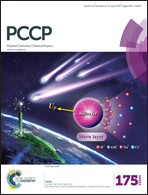Multidimensional operando analysis of macroscopic structure evolution in lithium sulfur cells by X-ray radiography†
Abstract
Lithium sulfur cells are the most promising candidate for the post lithium-ion battery era. Their major drawback is rapid capacity fading attributed to the complex electrochemical processes during charge and discharge which are not known precisely. Here we present for the first time a multidimensional operando measurement by combining X-ray radiography with impedance spectroscopy while galvanostatically charging and discharging a lithium sulfur cell. The formation of macroscopic sulfur crystals at the end of charge can be seen directly by X-ray radiography. These crystals can be assigned to stable α-sulfur (rhombic) and metastable β-sulfur (monoclinic) by their characteristic crystal habit. These crystal structures with a length of more than 1 mm form and dissolve rapidly during cycling. Their appearance is accompanied by characteristic signals in impedance spectroscopy. Macroscopic crystals of Li2S cannot be observed in full agreement with earlier studies by operando X-ray diffraction. In addition, X-ray radiography reveals non-wetted areas on the carbon cathode. These regions grow during discharge and are reduced during charge. The area of these electrochemically inactive spots is inversely proportional to discharge capacity.


 Please wait while we load your content...
Please wait while we load your content...